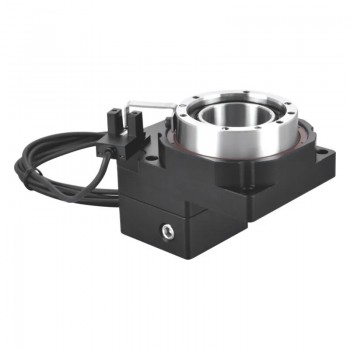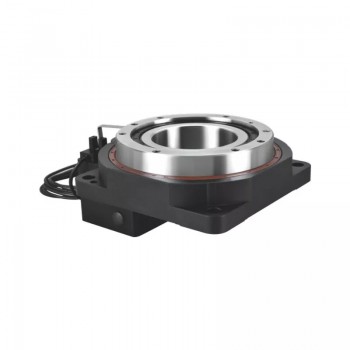1.Basic introduction of hollow rotary actuator
A hollow rotary actuator is a type of rotary actuator that features a central hollow bore through its output shaft. This design allows for the passage of cables, wiring, or piping through the center of the actuator, simplifying equipment design and potentially reducing size and weight. These actuators are often used in factory automation, robotics, and other applications where space is limited and the routing of utilities is critical.

2.Key features of hollow rotary actuator
1.Hollow Bore:The defining characteristic is the central opening in the output shaft, which can accommodate various cables, wires, or tubing.
2.Integration:Hollow rotary actuators often integrate the motor, encoder, and driver into a single, compact unit, simplifying wiring and control.
3.High Rigidity:Many models incorporate cross-roller bearings to handle significant thrust, radial, and moment loads, ensuring high accuracy and durability.
4.Flexibility:They are available in various sizes and with different mounting options to suit diverse applications.
5.Control:Some models offer advanced control features, including stand-alone control via a programming language, USB/RS-485/Ethernet communication, and compatibility with different amplifier types and communication networks.
3.Maintenance tips of hollow rotary actuator
1.Lubrication:Hollow rotary actuators often require specific types of grease or oil. Refer to the manufacturer’s specifications for the correct type and quantity. Regularly check for grease leaks, especially if the actuator is installed in a position where leakage could cause contamination.
2.Oil Level Check:If your actuator uses oil, check the oil level regularly. Locate the oil level screw plug and remove it to check the oil level. If the oil level is low, add the correct amount of the specified oil. Ensure the actuator is cool before checking the oil level, especially after operation.
3.Visual Inspection:Regularly inspect the actuator for any signs of wear, damage, or loose components. Check the mounting screws and ensure they are tightened to the correct torque. Look for any unusual noises or vibrations during operation, which could indicate a problem.
4.Correct Installation:Ensure the actuator is mounted correctly using the specified mounting holes and screws. Avoid using the positioning pins to remove or loosen the actuator, as this can affect positioning accuracy.
5.Environmental Considerations:Keep the area around the actuator clean and free of debris. Avoid operating the actuator in extreme temperatures or environments that could damage it. If the actuator is used in an environment with potential hazards (e.g., flammable materials), take appropriate safety precautions.
6.Safety Precautions:Always disconnect the power supply before performing any maintenance or inspection. Do not touch the actuator or its moving parts during operation. Use the correct actuator and driver combination as specified by the manufacturer.

4.Main application scenarios of hollow rotary actuators
1.Industrial automation: In the field of industrial automation, the hollow rotary actuator is one of the key components for realizing automated production lines. It can accurately transmit rotational motion to various mechanical equipment to ensure the accuracy and efficiency of the production process.
2.Robotics: In the field of robotics, hollow rotary actuators help robots achieve more flexible and precise motion control, thereby improving the robot’s work efficiency and precision. For example, using hollow rotary actuators at the robot joints can facilitate pipeline layout, make the manipulator move more smoothly, and perform complex tasks.
3.Medical equipment: In the field of medical equipment, hollow rotary actuators are used in surgical robots to ensure the precise movement and positioning of surgical instruments and improve the accuracy and safety of surgery. In addition, it can also be used in medical imaging diagnostic equipment to improve the accuracy of diagnosis.
4.Aerospace: In the field of aerospace, hollow rotary actuators ensure the accurate movement and positioning of various precision components, providing strong guarantees for the smooth progress of aerospace missions.
5.CNC equipment: In CNC machine tool equipment, hollow rotary actuators, as the fourth machining axis of the machine tool, can achieve more dimensional machining operations, expand machine tool functions, and improve machining accuracy.
6.Intelligent logistics system: In the intelligent logistics system, hollow rotary actuators are used in automated inspection equipment and industrial machinery equipment to improve inspection accuracy and production efficiency.